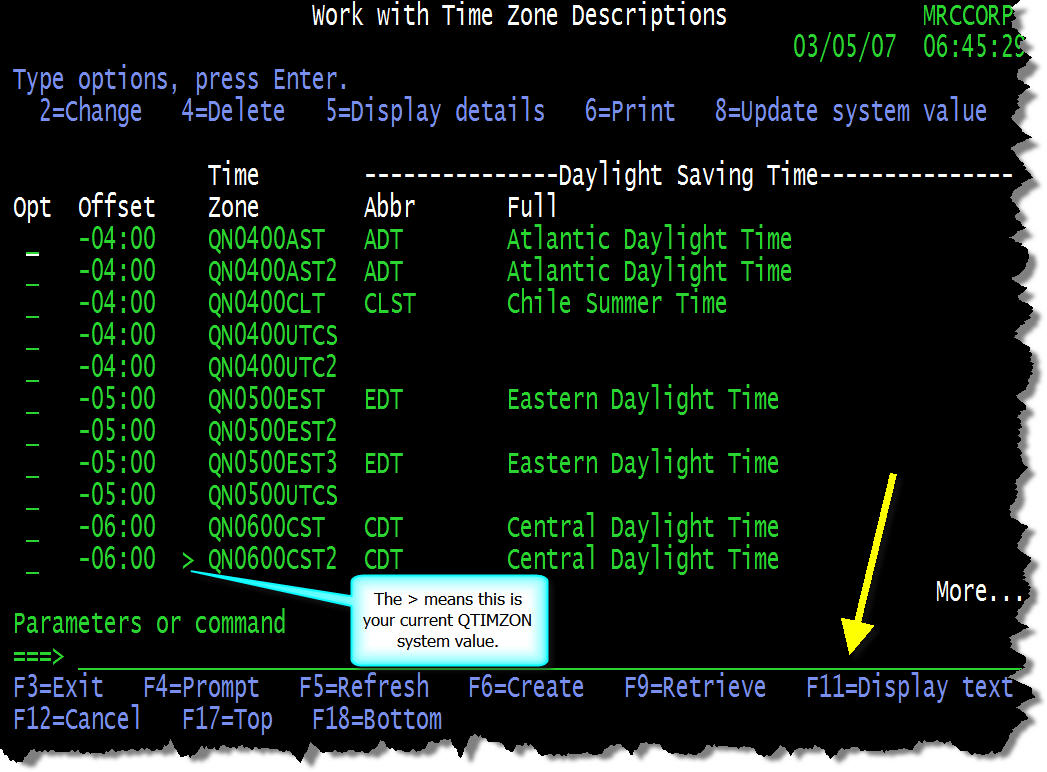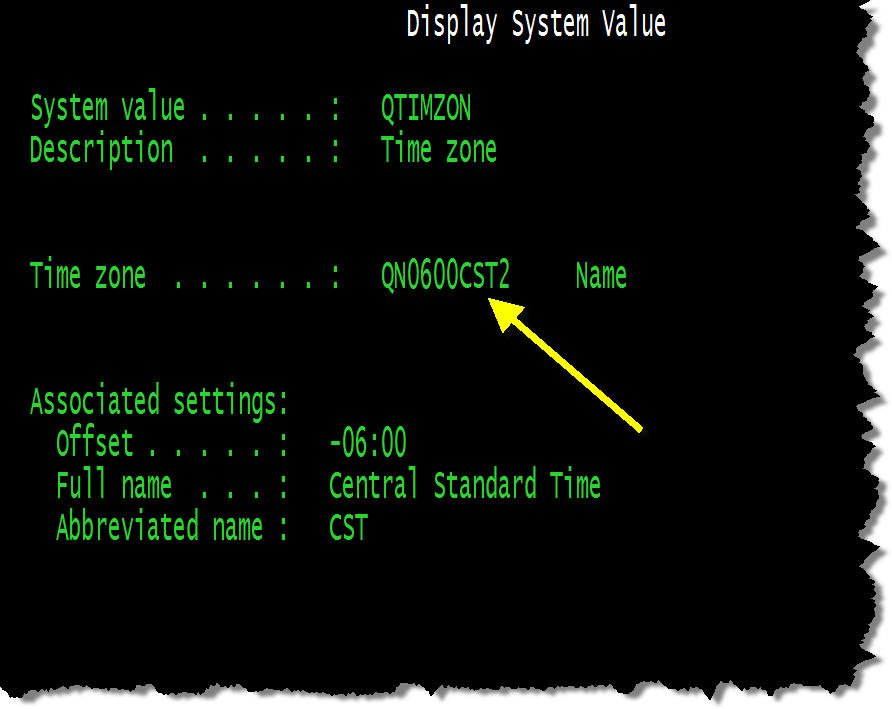Remember Y2K? Well, next Sunday seems to have a lot of people unnecessarily worried about the change in when Daylight Saving Time (DST) goes into effect.
I suppose if you are still running an iSeries with OS/400 V5R2 or earlier, you don't have DST support anyway, so you shouldn't be worried. It wasn't until V5R3 that IBM introduced DST to the iSeries world. The time zone system value (QTIMZON) specifies the name of the time zone description that is used to calculate local system time.
Just for the record, DST begins at 2:00 a.m. on March 11, 2007, so move your clocks ahead one hour. DST ends at 2:00 a.m. on November 11, 2007. You'll move your clocks back an hour then.
My System i5 system is running i5/OS V5R4. The QTIMZON system value is set to QN0600CST2. This is the Time Zone Descriptor that IBM created to indicate that we're at Zulu – 6 (this means I'm six hours earlier than Greenwich Mean Time).
A new command, Work with Time Zone Descriptors (WRKTIMZON), allows you to work with all the installed time zone descriptors. Although you probably don't need to use it, this command displays a list of all the various descriptors and allows you to easily select which one you want to use for your QTIMZON system value (type an 8 next to the time zone descriptor, and the QTIMZON system value is changed to this value). In addition, the F11 key can be used to toggle between displaying the DST descriptors only, standard time descriptors, or all descriptors (see Figure 1).
Figure 1: With the WRKTIMZON command, you can use the F11 key to toggle between displaying the DST descriptors only, standard time descriptors, or all descriptors. (Click images to enlarge.)
It may appear as though there are duplicate time zone descriptors, but many are simply the result of installing IBM PTFs for DST. For example, the QN0600CST2 descriptor represents the new DST standard, whereas QN0600CST represents the original DST standard.
If you display the QTIMZON value, it will look similar to Figure 2 (shown on my machine):
Figure 2: Display the QTIMZON system value.
If you're on V5R2 and DST is important, you have to adjust your applications so that they access this kind of information via Internet Web sites, SOA, or another method. Or you may have to move to V5R3 or V5R4.
If you are running V5R3 or later, IBM has PTFs that will correct the change in DST duration:
- V5R3—SI26039 and SI25991
- V5R4—SI26040 and SI25990
If you're current on PTF packages, these PTFs are probably already applied to your system. If not, you need to make sure you get them installed in the next few days. Go to the IBM OS/400 and i5/OS DST PTF Web site to find out more about this issue.
To find out more about DST, visit the National Institute of Standards Web page on DST.
What About Java?
Normally, I would say, "Who cares?" But Java is finally becoming relatively useful. I now use it to send email responses to people who register on the discussion forum at RPGIV.com/forum, and it works well.
IBM's Java has all kinds of PTFs listed for DST support. Since the Java Developer Kit (JDK) is at various levels, there are various PTFs based on the JDK release and the i5/OS release you're running. Here's a short matrix; identify your JDK and i5/OS release and pull down the PTF(s) you'll need.
| PTFs DST Support | |||
| JDK Version | V5R2 | V5R3 | V5R4 |
| 1.2.2 | SI26480 | N/A | N/A |
| 1.3.1 | SI25967 | SI25968 | SI25969 |
| 1.4 | SI25966 | SI26838 | SI26839 |
If you're using Unicode (most people are not, but some are), you need one of the following PTFs for your ICU DST (5722SS1 Option 29):
- V5R4M0—SI25400
- V5R3M0—SI25399
At the end of the day, you may forget to turn your clocks forward an hour ("spring forward, fall back"), but your iSeries should be keeping pace with the rest of the world, provided you've installed these DST PTFs.
Bob Cozzi is author of the best-selling The Modern RPG IV Language, Fourth Edition as well as RPG TNT: 101 Dynamite Tips 'n Techniques with RPG IV and is host of the i5 Podcast Network, which provides free video and audio podcasts to the i5 community. You can also see him in person at RPG World in May 2007.

















 Business users want new applications now. Market and regulatory pressures require faster application updates and delivery into production. Your IBM i developers may be approaching retirement, and you see no sure way to fill their positions with experienced developers. In addition, you may be caught between maintaining your existing applications and the uncertainty of moving to something new.
Business users want new applications now. Market and regulatory pressures require faster application updates and delivery into production. Your IBM i developers may be approaching retirement, and you see no sure way to fill their positions with experienced developers. In addition, you may be caught between maintaining your existing applications and the uncertainty of moving to something new. IT managers hoping to find new IBM i talent are discovering that the pool of experienced RPG programmers and operators or administrators with intimate knowledge of the operating system and the applications that run on it is small. This begs the question: How will you manage the platform that supports such a big part of your business? This guide offers strategies and software suggestions to help you plan IT staffing and resources and smooth the transition after your AS/400 talent retires. Read on to learn:
IT managers hoping to find new IBM i talent are discovering that the pool of experienced RPG programmers and operators or administrators with intimate knowledge of the operating system and the applications that run on it is small. This begs the question: How will you manage the platform that supports such a big part of your business? This guide offers strategies and software suggestions to help you plan IT staffing and resources and smooth the transition after your AS/400 talent retires. Read on to learn:
LATEST COMMENTS
MC Press Online